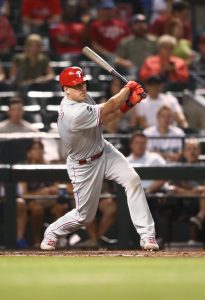A team in a total rebuild is open to giving any player a chance, particularly when that team is drastically short on starting pitching. With the Orioles in such a state in April 2019, it paved the way for John Means to enter the Orioles’ rotation, on the heels of three relief outings earlier that season and one (disastrous) 3 1/3-inning appearance in his Major League debut on September 26, 2018. That outing saw Means surrender five earned runs, giving him an ugly 13.50 ERA heading into the 2019 campaign.
Means didn’t exactly force his way into the rotation during Spring Training, with only a 5.40 ERA over 13 1/3 frames of 2019 Grapefruit League action. Still, the southpaw did manage 15 strikeouts against just four walks, and given the lack of other pitching options available in Baltimore, the O’s figured it was worth giving Means a shot.
The result was one of the only bright spots of a 108-loss season for the Orioles. Over 27 outings and 147 1/3 innings as a starting pitcher, Means posted a 3.73 ERA, 3.09 K/BB rate, and 6.6 K/9. The majority of that production came in the first half of the season, as Means carried a 2.50 ERA through his first 82 2/3 innings and ended up as Baltimore’s All-Star representative.
Means struggled to a 8.34 ERA in his first five post-break starts, though he did manage to get on track with a 3.26 ERA over his final 49 2/3 frames of his rookie season. As a nod to his breakout performance, Means finished second in AL Rookie Of The Year voting, albeit a distant runner-up behind unanimous winner Yordan Alvarez.
Whenever (or if) the 2020 season gets underway, Means will stand as the de facto ace of the Orioles’ staff — an unlikely development given where he was slightly more than a year ago. An 11th-round pick in the 2014 draft, Means moved through the farm system with unspectacular but solid numbers over his 622 2/3 minor league innings, posting a 3.83 ERA, 7.1 K/9, and 3.50 K/BB rate. There isn’t much variance in Means’ year-to-year cumulative stats in the minors, or even in his MLB numbers in 2019.
That type of consistency gives the O’s some hope that Means can at least somewhat replicate his 2019 performance going forward, despite some of the red flags raised by advanced metrics. Means’ ERA predictors weren’t impressive, with a FIP (4.41), xFIP (5.48), and SIERA (5.02) that were all markedly higher than his actual 3.60 ERA. The lack of a high strikeout total hurts Means in this respect, and he also isn’t a hard thrower (average fastball velocity of 91.8 mph) or a ground-ball machine.
What he does offer is the ability to limit the damage when opposing batters do hit his offerings. As per Statcast, Means finished in the 90th percentile of all pitchers in fewest hard-hit balls allowed, while also sitting comfortably above average (72nd percentile) in exit velocity. Means also had only a 9.9% homer/fly ball rate last season, the fourth-lowest mark of any pitcher in baseball with at least 150 IP and a particularly useful skill for a hurler in the tough AL East.
Means’ heater isn’t particularly fast, though he does generate some good spin, as indicated by his spot in the 75th percentile of fastball spin rate. His top pitch, however, is a changeup that Fangraphs ranked as one of the best in the league last season. Only six pitchers with 150+ innings thrown had a better pitch value score on a changeup than Means’ +12.3 number.
Means just turned 27 yesterday and is under team control through the 2024 season (and not arbitration-eligible until the 2021-22 offseason), giving the O’s plenty of flexibility with his future. Given the long rebuild ahead for the Orioles, it may be a reach to count on Means to still be a productive member of the rotation by the time Baltimore is next ready to contend, so the O’s could eventually consider him as a trade chip.
There wasn’t much buzz about Means on the rumor mill this past winter, as while Baltimore is still at the point of its rebuild that any trade option must be considered, the club might prefer to see what they have with the left-hander in his sophomore year. A case could be made that the O’s should have sold high on Means given his lack of a track record, and yet even with some regression baked into his future numbers, the potential of Means being a solid innings-eater going forward carries a lot of value. For a team with so little pitching depth on hand, an unheralded prospect blossoming into at least a decent MLB-level arm counts as a big success.


